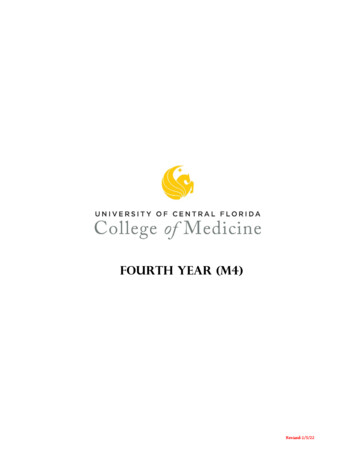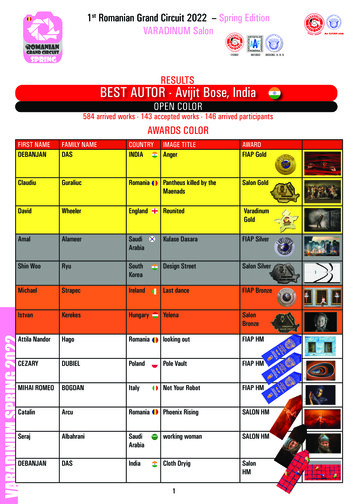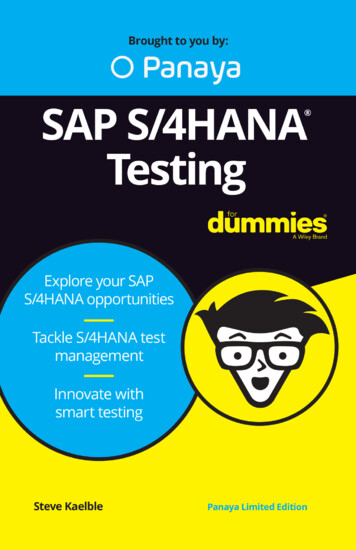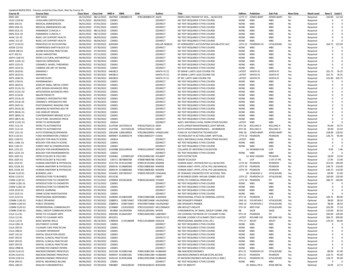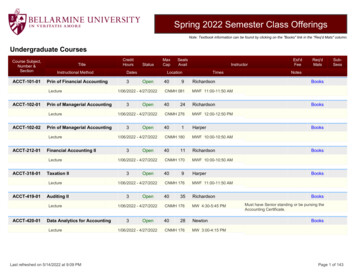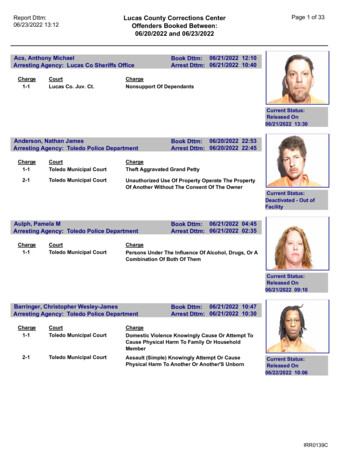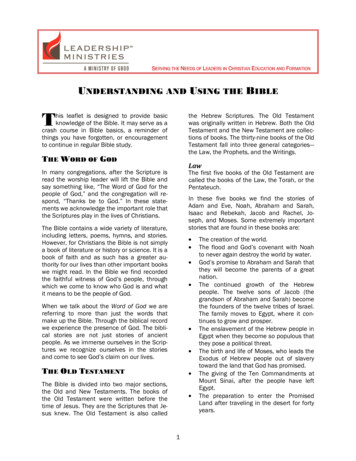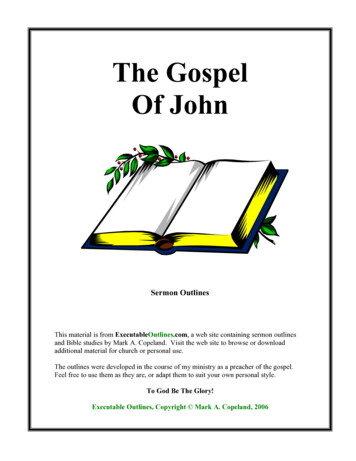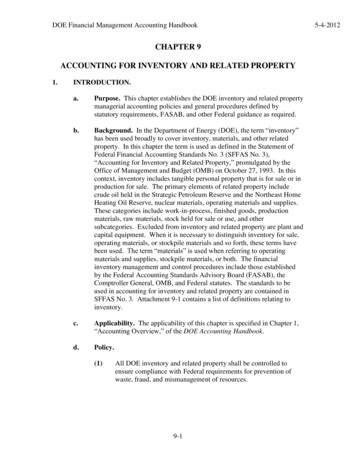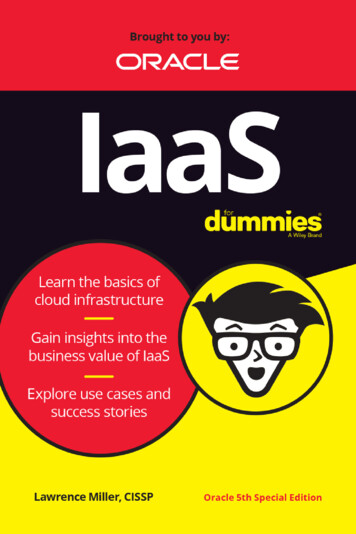
Transcription
These materials are 2022 John Wiley & Sons, Inc. Any dissemination, distribution, or unauthorized useis strictly prohibited.
IaaSThese materials are 2022 John Wiley & Sons, Inc. Any dissemination, distribution, or unauthorized useis strictly prohibited.
IaaSOracle 5th Special Editionby Lawrence Miller, CISSPThese materials are 2022 John Wiley & Sons, Inc. Any dissemination, distribution, or unauthorized useis strictly prohibited.
IaaS For Dummies , Oracle 5th Special EditionPublished byJohn Wiley & Sons, Inc.111 River St.Hoboken, NJ 07030-5774www.wiley.comCopyright 2022 by John Wiley & Sons, Inc., Hoboken, New JerseyNo part of this publication may be reproduced, stored in a retrieval system or transmittedin any form or by any means, electronic, mechanical, photocopying, recording, scanningor otherwise, except as permitted under Sections 107 or 108 of the 1976 United StatesCopyright Act, without the prior written permission of the Publisher. Requests to thePublisher for permission should be addressed to the Permissions Department, John Wiley& Sons, Inc., 111 River Street, Hoboken, NJ 07030, (201) 748-6011, fax (201) 748-6008, oronline at http://www.wiley.com/go/permissions.Trademarks: Wiley, For Dummies, the Dummies Man logo, The Dummies Way, Dummies.com, Making Everything Easier, and related trade dress are trademarks or registeredtrademarks of John Wiley & Sons, Inc. and/or its affiliates in the United States and othercountries, and may not be used without written permission. All other trademarks are theproperty of their respective owners. John Wiley & Sons, Inc., is not associated with anyproduct or vendor mentioned in this book.LIMIT OF LIABILITY/DISCLAIMER OF WARRANTY: WHILE THE PUBLISHER AND AUTHORS HAVE USED THEIRBEST EFFORTS IN PREPARING THIS WORK, THEY MAKE NO REPRESENTATIONS OR WARRANTIES WITHRESPECT TO THE ACCURACY OR COMPLETENESS OF THE CONTENTS OF THIS WORK AND SPECIFICALLYDISCLAIM ALL WARRANTIES, INCLUDING WITHOUT LIMITATION ANY IMPLIED WARRANTIES OFMERCHANTABILITY OR FITNESS FOR A PARTICULAR PURPOSE. NO WARRANTY MAY BE CREATED OREXTENDED BY SALES REPRESENTATIVES, WRITTEN SALES MATERIALS OR PROMOTIONAL STATEMENTSFOR THIS WORK. THE FACT THAT AN ORGANIZATION, WEBSITE, OR PRODUCT IS REFERRED TO INTHIS WORK AS A CITATION AND/OR POTENTIAL SOURCE OF FURTHER INFORMATION DOES NOT MEANTHAT THE PUBLISHER AND AUTHORS ENDORSE THE INFORMATION OR SERVICES THE ORGANIZATION,WEBSITE, OR PRODUCT MAY PROVIDE OR RECOMMENDATIONS IT MAY MAKE. THIS WORK IS SOLD WITHTHE UNDERSTANDING THAT THE PUBLISHER IS NOT ENGAGED IN RENDERING PROFESSIONAL SERVICES.THE ADVICE AND STRATEGIES CONTAINED HEREIN MAY NOT BE SUITABLE FOR YOUR SITUATION. YOUSHOULD CONSULT WITH A SPECIALIST WHERE APPROPRIATE. FURTHER, READERS SHOULD BE AWARETHAT WEBSITES LISTED IN THIS WORK MAY HAVE CHANGED OR DISAPPEARED BETWEEN WHEN THISWORK WAS WRITTEN AND WHEN IT IS READ. NEITHER THE PUBLISHER NOR AUTHORS SHALL BE LIABLEFOR ANY LOSS OF PROFIT OR ANY OTHER COMMERCIAL DAMAGES, INCLUDING BUT NOT LIMITED TOSPECIAL, INCIDENTAL, CONSEQUENTIAL, OR OTHER DAMAGES.ISBN 978-1-119-90952-1 (pbk); ISBN 978-1-119-90953-8 (ebk)For general information on our other products and services, or how to create a custom ForDummies book for your business or organization, please contact our Business DevelopmentDepartment in the U.S. at 877-409-4177, contact info@dummies.biz, or visit www.wiley.com/go/custompub. For information about licensing the For Dummies brand for products orservices, contact BrandedRights&Licenses@Wiley.com.Publisher’s AcknowledgmentsSome of the people who helped bring this book to market include the following:Development Editor: Elizabeth KuballProduction Editor: Tamilmani VaradharajCopy Editor: Elizabeth KuballSpecial Help: Faye Hutsell,Akshai Parthasarathy,Kellsey Ruppel, Savita Raina,Erin Prewitt, Nader Mikhail,Julie MillerAcquisitions Editor: Ashley CoffeyEditorial Manager: Rev MengleClient Account Manager: Jeremith CowardThese materials are 2022 John Wiley & Sons, Inc. Any dissemination, distribution, or unauthorized useis strictly prohibited.
Table of ContentsIntroduction. . . . . . . . . . . . . . . . . . . . . . . . . . . . . . . . . 1Foolish Assumptions . . . . . . . . . . . . . . . . . . . . . . . . . 1Icons Used in This Book . . . . . . . . . . . . . . . . . . . . . . 2Beyond the Book . . . . . . . . . . . . . . . . . . . . . . . . . . . . 3CHAPTER 1:Challenges and Opportunities . . . . . . . . . . . . . 5Defining Cloud Computing Fundamentals. . . . . . . 6Characterizing the Enterprise Workload . . . . . . . . 9Understanding the Value of IaaS in theEnterprise. . . . . . . . . . . . . . . . . . . . . . . . . . . . . . . . 12Introducing Oracle Cloud Infrastructure . . . . . . . 13Oracle Cloud for Independent SoftwareVendors (ISVs) . . . . . . . . . . . . . . . . . . . . . . . . . . . . 16CHAPTER 2:Exploring Oracle Cloud Infrastructure . . . . . 19Oracle Cloud Infrastructure ComputeShapes . . . . . . . . . . . . . . . . . . . . . . . . . . . . . . . . . . 20Oracle Cloud InfrastructureCompute Virtualization. . . . . . . . . . . . . . . . . . 23Oracle Cloud Native Services . . . . . . . . . . . . . . 24Platform services . . . . . . . . . . . . . . . . . . . . . . . . 28Migration services . . . . . . . . . . . . . . . . . . . . . . . 29Oracle Cloud Infrastructure Storage . . . . . . . . . . . 29Local NVMe storage . . . . . . . . . . . . . . . . . . . . . . 29Block volumes. . . . . . . . . . . . . . . . . . . . . . . . . . . 29File Storage . . . . . . . . . . . . . . . . . . . . . . . . . . . . . 30Object Storage . . . . . . . . . . . . . . . . . . . . . . . . . . 30Archive Storage. . . . . . . . . . . . . . . . . . . . . . . . . . 31Data Transfer Service. . . . . . . . . . . . . . . . . . . . . 31These materials are 2022 John Wiley & Sons, Inc. Any dissemination, distribution, or unauthorized useis strictly prohibited.
Database Service . . . . . . . . . . . . . . . . . . . . . . . . 32Autonomous Database services . . . . . . . . . . . 32Database Backup Service . . . . . . . . . . . . . . . . . 34Oracle Cloud Infrastructure Networking . . . . . . . 34CHAPTER 3:Connecting to Oracle Cloud Infrastructure. . . 37Enterprise Requirements forConnecting to the Cloud . . . . . . . . . . . . . . . . . . . 38Oracle FastConnect . . . . . . . . . . . . . . . . . . . . . . . . . 40Oracle VPN Connect . . . . . . . . . . . . . . . . . . . . . . . . 43CHAPTER 4:Examining IaaS Use Casesand Success Stories . . . . . . . . . . . . . . . . . . . . . 47Lifting and Shifting Oracle Applicationsto the Cloud . . . . . . . . . . . . . . . . . . . . . . . . . . . . . . 48Utilizing High-Performance Computing (HPC) . . . 52Building and Deploying Cloud-Native Apps . . . . . 55Running Custom Apps on OCI . . . . . . . . . . . . . . . . 57CHAPTER 5:Ten (or So) Advantages of Oracle CloudInfrastructure . . . . . . . . . . . . . . . . . . . . . . . . . . 61Performance . . . . . . . . . . . . . . . . . . . . . . . . . . . . . . . 62Superior Economics. . . . . . . . . . . . . . . . . . . . . . . . . 63Predictability . . . . . . . . . . . . . . . . . . . . . . . . . . . . . . . 63Availability . . . . . . . . . . . . . . . . . . . . . . . . . . . . . . . . . 64Openness . . . . . . . . . . . . . . . . . . . . . . . . . . . . . . . . . 66Choice of Deployment. . . . . . . . . . . . . . . . . . . . . . . 66Governance and Control. . . . . . . . . . . . . . . . . . . . . 68Observability and Management . . . . . . . . . . . . . . 70Scalability . . . . . . . . . . . . . . . . . . . . . . . . . . . . . . . . . 71Optimized for Oracle Applicationsand Databases. . . . . . . . . . . . . . . . . . . . . . . . . . . . 72Security by Design . . . . . . . . . . . . . . . . . . . . . . . . . . 73Service-Level Guarantees . . . . . . . . . . . . . . . . . . . . 74These materials are 2022 John Wiley & Sons, Inc. Any dissemination, distribution, or unauthorized useis strictly prohibited.
IntroductionTo succeed in today’s competitive environment,businesses need to free themselves from the limitations of legacy IT infrastructure. The days ofpurchasing hardware and maintaining massive data centers to run IT have to end. Managing and maintaininginfrastructure is simply too expensive.According to IDC, worldwide spending on public cloudservices grew 26 percent in 2019 to a total of 233.4 billion, up from 185.2 billion in 2018. Utilizingcloud-based infrastructure with an elastic, pay-asyou-go service model not only reduces costs and worries,but also frees IT organizations to innovate in ways thatwill enhance business growth.Foolish AssumptionsIt has been said that most assumptions have outlived theiruselessness, but I assume a couple things nonetheless:»You work as a CIO, CTO, SVP, VP, director, orenterprise architect, responsible for some or allIT infrastructure components (such as compute,1These materials are 2022 John Wiley & Sons, Inc. Any dissemination, distribution, or unauthorized useis strictly prohibited.
storage, and networking) in an enterprise that hasalready adopted — or is currently developing — acloud computing strategy.»You have some familiarity with popular publiccloud offerings, such as Amazon Web Services(AWS) and Microsoft Azure, but you’re less aware ofOracle’s cloud and portfolio of enterprise solutions.Icons Used in This BookThroughout this book, I occasionally use icons to call outimportant information. Here’s what to expect.This icon points out information you shouldcommit to memory.This icon explains the jargon beneath thejargon.This icon points out helpful suggestions anduseful nuggets of information.2These materials are 2022 John Wiley & Sons, Inc. Any dissemination, distribution, or unauthorized useis strictly prohibited.
Beyond the BookThere’s only so much I can cover, so if you find yourselfat the end of this book thinking, “Where can I learnmore?,” just go to www.oracle.com/cloud. There, you canlearn more about infrastructure as a service (IaaS) andOracle Cloud Infrastructure (OCI). You can give IaaS a tryat www.oracle.com/cloud/free.3These materials are 2022 John Wiley & Sons, Inc. Any dissemination, distribution, or unauthorized useis strictly prohibited.
IN THIS CHAPTER» Getting started with a few clouddefinitions» Addressing enterprise workloadrequirements» Realizing the cost andconvenience benefits of IaaS» Discovering Oracle CloudInfrastructure (OCI)» Extending Oracle Cloud toindependent software vendors(ISVs)Chapter1Challenges andOpportunitiesIn this chapter, you find out about IaaS, cloud computing, enterprise workloads, and the value they provideto businesses seeking to deliver more innovation andagility in their markets.5These materials are 2022 John Wiley & Sons, Inc. Any dissemination, distribution, or unauthorized useis strictly prohibited.
Defining Cloud ComputingFundamentalsThe term cloud has become a part of our modern ITlexicon, and there are many definitions and distinctionsof different cloud deployment and service models. To tryto cut down a bit on the cloudwashing (a term Gartneruses to refer to the marketing practice of adding the wordcloud to practically any technology product or service),let’s keep it simple.There are five essential characteristics of the cloud (asdefined by the National Institute of Standards and Technology, or NIST):»»»»»On-demand self-serviceBroad network accessResource poolingRapid elasticityMeasured serviceAnd there are three basic cloud deployment models:»»»PublicPrivateHybrid6These materials are 2022 John Wiley & Sons, Inc. Any dissemination, distribution, or unauthorized useis strictly prohibited.
Finally, there are three basic cloud service models:»»»Software as a service (SaaS)Platform as a service (PaaS)Infrastructure as a service (IaaS)A key difference among SaaS, PaaS, and IaaS is the levelof control that the enterprise has with the cloud stack.The demarcation line for IaaS is typically at the operatingsystem: The cloud provider manages the virtualization,servers, storage, networking, and data center, while theenterprise is responsible for configuring and maintainingsoftware at the operating system layer and above, including middleware, runtime environments, data, and application software (see Figure 1-1).Next-generation IaaS offerings extend customer controldeeper into the cloud stack, with the option to managevirtualization, servers, and storage, while simultaneously offering higher levels of predictable performance,control, and security than first-generation IaaS platforms. Whereas first-generation IaaS offerings providecloud-based virtual machines (VMs) in a multitenantenvironment (meaning several customers may shareresources on the same server, while only being able toaccess the portion of the server that’s allocated for theirusage), second-generation IaaS offerings can also provide on-demand, single-tenant bare metal machines(where each physical server is dedicated solely to onecustomer).7These materials are 2022 John Wiley & Sons, Inc. Any dissemination, distribution, or unauthorized useis strictly prohibited.
SaaSPaaSIaaSIaaSFirst GenerationNext kingData CenterData CenterData CenterData CenterManaged byEnterprise orService ProviderManaged byService ProviderManaged byEnterpriseFIGURE 1-1: Different cloud service models provide differentlevels of control for the enterprise.I tell you more about next-generation IaaSofferings in Chapter 2.8These materials are 2022 John Wiley & Sons, Inc. Any dissemination, distribution, or unauthorized useis strictly prohibited.
Characterizing the EnterpriseWorkloadEnterprise applications run the business. They rangefrom core, indispensable systems to customer relationship management and social and mobile platforms, toname just a few. Every business is different, but at a veryhigh level, common expectations for enterprise workloads in the cloud include the following:»»»Elasticity and massive scalability: No resource isinfinite or unlimited, but a world-class cloud serviceprovider has more available capacity than enterprises, so resource utilization can be perfectlybalanced in the cloud, where you can automaticallyscale up, out, and down as needed (providedyou’ve architected your applications appropriately).Predictability: Enterprises are constantly tweakinginfrastructure to provide consistent performancefor their mission-critical applications. Though manyfirst-generation IaaS cloud platforms don’t offerthis capability, it’s key to successfully runningenterprise workloads in the public cloud.High performance: Enterprise applicationstypically require very low latency, high throughput,and high input/output operations per second(IOPS).9These materials are 2022 John Wiley & Sons, Inc. Any dissemination, distribution, or unauthorized useis strictly prohibited.
»»»Open standards and workload/data portability:In the cloud, there aren’t many industry standardsgoverning things like application programminginterfaces (APIs), management, and orchestration.For this reason, some clouds are quite proprietaryand you risk getting “locked in” with a singleprovider. Also, with some providers, although it’srelatively easy to move your applications and datato the cloud, moving them (or even the data theyutilize) back can be very difficult if your cloudstrategy or needs change.Security and trustworthiness: There are manylayers to security in the cloud that need to beconsidered, and enterprises must feel confidentthat their workloads and data are secure.Service-level agreements (SLAs): SLAs vary widelyin terms of the uptime and performance guarantees, as well as the remediation provided if an SLAviolation occurs.Enterprises also expect to be able to extend their governance models to the public cloud. IT leaders have beenmanaging on-premises environments for years. Theyrequire visibility into who is accessing which resourcesand when, and they’re accustomed to delegating permissions and granting access to resources. Systems of recordand governance just don’t change overnight. Your cloudprovider should offer the ability to extend governance tothe cloud natively with the following capabilities:10These materials are 2022 John Wiley & Sons, Inc. Any dissemination, distribution, or unauthorized useis strictly prohibited.
»»»»»»Identity and access management (IAM):Authorize who can perform specific actions onspecific resources, with full control and visibility tocentrally manage cloud resources.Role-based access control (RBAC): You havedifferent levels of control for providing access tovarious types of infrastructure resources at theaccount, sub-account, or resource level.Resource visibility: When IAM and RBAC areutilized and resources are logically defined, aunified view of permissions and security policiesbecomes available to IT administrators.Quotas: Limit which resources are available andwhen, based on specific criteria defined by theorganization.Showback/chargeback: Audit trails allowinfrastructure usage costs to be allocated todepartments, business units, or individual users.Tagging: Enables users to search, control access,and do bulk actions on a set of resources based onthe tag. For example, you can add tags to describethe business organizations that are responsible fora resource.11These materials are 2022 John Wiley & Sons, Inc. Any dissemination, distribution, or unauthorized useis strictly prohibited.
Understanding the Value ofIaaS in the EnterpriseThe motivations for businesses to adopt IaaS are diverseand can be broadly organized as follows:»»»Reducing dependence on the corporate datacenter: Moving centralized IT workloads offpremises and lowering or eliminating the need tomanage facilities and infrastructureUsing IaaS for specific initiatives: Responding toline-of-business requests for on-demand infrastructure to support new application initiativesDeveloping cloud-native applications:Developing and deploying new applications usingnative cloud infrastructure capabilities and moreagile technologies like containers and serverlesscomputingIaaS provides increased speed and agility by offering ondemand, self-service access to compute, storage, andnetworking resources in the cloud. Developers and application owners can get access to infrastructure to runtheir applications in minutes, and the cloud providesresource elasticity to scale up and down, providing significant flexibility that isn’t typically possible in an onpremises environment. IaaS can enable significant IT12These materials are 2022 John Wiley & Sons, Inc. Any dissemination, distribution, or unauthorized useis strictly prohibited.
cost savings by reducing hardware and data center management overhead while offering a pay-only-forwhat-you-use pricing model. This is in contrast to procuring hardware for peak capacity requirements and payingfor idle capacity that is underutilized during nonpeak times.According to 451 Research, “There is now astrong public cloud option for almost everykind of application and computing workload.An entire generation of IT talent has noweffectively grown up with the IaaS model.”Whether your business is already headed tothe cloud or not, it’s a safe bet that yourcompetition is!Introducing Oracle CloudInfrastructureEnterprises need a cloud environment that replicatestheir on-premises data center environment — whetherfor business applications, databases on a dedicated cluster, or a fully integrated and managed solution — whilealso providing all the benefits of the public cloud.Oracle Cloud Infrastructure (OCI) is focused on transforming the cloud experience to become adaptable toyour business and your desire to innovate. Oracle built acloud that is autonomous, scalable, and purpose-built for13These materials are 2022 John Wiley & Sons, Inc. Any dissemination, distribution, or unauthorized useis strictly prohibited.
all enterprise workloads, from legacy to cloud native.Designed to serve the cloud-connected experience,Oracle Cloud offers lower, predictable, and globally consistent pricing to optimize the way data moves in themodern enterprise. OCI’s pricing is among the mostcompetitive in the industry.With the Oracle Cloud, organizations get all the benefitsof the cloud with the same control, isolation, security,and predictable performance as their on-premises datacenters.Oracle’s IaaS offering includes the following types ofservices:»»Compute: Whether a workload requires a singleVM or demands the high performance, consistency,and isolation offered by bare metal servers, Oracleoffers a broad spectrum of cloud compute optionsthat are equipped with Intel-, AMD-, and ARMbased CPUs. Oracle’s compute options includeVMs, bare metal instances, and GPUs with baremetal or VMs.Storage: Secure and scalable cloud-based storagesolutions ideal for storing and accessing data fromany environment connected to the Internet.Offerings include local Non-Volatile MemoryExpress (NVMe) flash storage, network file storage,network block storage, object storage, archive14These materials are 2022 John Wiley & Sons, Inc. Any dissemination, distribution, or unauthorized useis strictly prohibited.
storage, database backup storage, data transferservice, and even a software storage gateway.»Network: Any on-premises data center can beconnected to OCI via VPN or FastConnect, allowingorganizations to have a private, secure, highbandwidth, dedicated link between their on-premisesdata center and the Oracle Cloud.OCI provides comprehensive networkingand load balancing capabilities. Flexible loadbalancers, for example, scale load balancingneeds based on minimum and maximumbandwidth specified by the customer.Oracle’s Virtual Cloud Network featuresenable organizations to deploy highlyavailable, secure network topologies andmatch on-premises setups, thus not havingto rewrite networking specifications withinapplications.»»Edge and connectivity: Oracle also providesnetwork edge services such as DNS. To enablehybrid deployments, Oracle offers dedicatedconnectivity between Oracle cloud regions andon-premises data centers via FastConnect, andsecure Internet connectivity via VPN services.Containers: Oracle offers a production-gradeenvironment to run container-based applications.Whether customers want to bring their owninfrastructure or leverage Oracle’s managed15These materials are 2022 John Wiley & Sons, Inc. Any dissemination, distribution, or unauthorized useis strictly prohibited.
Kubernetes service, applications can benefit from thehigh-performance, highly available infrastructure.»Autonomous Database: OCI’s AutonomousDatabase is a fully managed, preconfigureddatabase environment with three workload typesavailable — Autonomous Transaction Processing,Autonomous Data Warehouse, and AutonomousJSON Database. You don’t need to configure ormanage any hardware or install any software. Afterprovisioning, you can scale the number of CPUcores or the storage capacity of the database at anytime without impacting availability or performance.In the IDC 2020 Industry CloudPath report, 935IaaS customers were surveyed on their satisfaction with top IaaS vendors including Oracle, Amazon Web Services, Microsoft, IBM,and Google Cloud. Oracle IaaS (OCI) receivedthe highest satisfaction score and the biggestyear-over-year score increase of all IaaSvendors.Oracle Cloud for IndependentSoftware Vendors (ISVs)With a global SaaS market valued at 117 billion as of2021, independent software vendors (ISVs) are in a primeposition to harness cloud technology and all its benefits,16These materials are 2022 John Wiley & Sons, Inc. Any dissemination, distribution, or unauthorized useis strictly prohibited.
whether it’s to accelerate go-to-market strategies,unlock almost exponential global growth, or create morebespoke solutions to meet very specific customer needs.Oracle provides cloud technology to ISVs around theworld, helping them provide best-of-breed service andfuture-ready infrastructure to their customers. OCI isbuilt specifically for enterprises looking for higher performance, lower costs, and easier cloud migration fortheir existing on-premises applications. But it’s not juston-premises customers who are migrating. Many Oraclecustomers and partners have moved from other cloudvendors to Oracle’s next-generation cloud infrastructure,benefiting from flexibility, competitive costs, rapid provisioning, and global-scale cloud support.Chapter 4 provides examples of customers,including ISVs, that are using OCI.View more hese materials are 2022 John Wiley & Sons, Inc. Any dissemination, distribution, or unauthorized useis strictly prohibited.
IN THIS CHAPTER» Calculating compute choices» Weighing storage options» Selecting network servicesChapter2Exploring OracleCloudInfrastructureIn this chapter, you learn about the capabilities, features, and competitive differentiators of Oracle’sinfrastructure as a service (IaaS) offering, called OracleCloud Infrastructure (OCI).19These materials are 2022 John Wiley & Sons, Inc. Any dissemination, distribution, or unauthorized useis strictly prohibited.
Oracle Cloud InfrastructureCompute ShapesOracle Cloud offers a variety of compute options to suityour organization’s needs with a resilient infrastructureservice that provides rapidly provisioned bare metal andvirtual machines (VMs) in single-tenant and multitenantconfigurations, respectively.A single-tenant environment in the cloud is ahost machine dedicated entirely to a singlecustomer, whereas a multitenant environmentis a host machine in a VM model that oftenhosts multiple customers.When you’re trying to determine which compute optionswill meet your organization’s needs, be sure to considerthe following factors:»»»Available CPU sizes: How much processing powerdo your applications and workloads require?Available graphics processing units (GPUs): Howmuch graphics processing power do your workloads require?Metered versus unmetered pricing: Do you needa “pay-as-you-go” option or the option to pay forunlimited usage over a specific period?20These materials are 2022 John Wiley & Sons, Inc. Any dissemination, distribution, or unauthorized useis strictly prohibited.
»»Single tenant or multitenant: Do your securityand compliance requirements necessitateinfrastructure that is dedicated solely to yourorganization?Support for containers: Are your developersactively writing next-generation applications usingcontainer technologies such as Docker andKubernetes?The table at www.oracle.com/cloud/compute/pricing.html will help you match the bestcompute service options to your organization’s needs, based on your answers to thepreceding questions.OCI offers flexible shapes. These shapes allow you to customize the number of OCPUs and the amount of memorywhen launching or resizing your VM. This flexibilityenables you to build VMs that match your workload, allowing you to optimize performance and minimize cost. Virtualized CPU instances can be selected from 1 to 64 coresand up to 64GB of memory per core, with a maximum of1,024GB total. Networking speeds clock from 700 Mbps to240 Gbps, and remote block storage or even 25.6TB ofdirect-attached NVMe flash storage are available.An OCPU is the CPU capacity equivalent ofone physical core of an Intel Xeon processorwith hyperthreading enabled or one physicalcore of an Oracle SPARC processor.21These materials are 2022 John Wiley & Sons, Inc. Any dissemination, distribution, or unauthorized useis strictly prohibited.
For even higher performance, OCI bare metal serversprovide customers isolation, visibility, and control of anentire dedicated server. For the most demanding applications, Oracle’s bare metal instances scale up to 128 cores(the largest in the industry), 2TB of RAM, up to 1PB ofblock storage, networking from single 25 Gbps to dual50 Gbps to 100 Gbps ultra-low-latency Remote DirectMemory Access (RDMA), and storage options including51.2TB of NVMe flash storage.OCI also offers a range of GPUs in both bare metal andvirtualized configurations with a range of memory, storage, and networking — even including the GPU-specificNVIDIA Tesla (Pascal or Volta).OCPU is defined as the CPU capacity equivalent of one physical core of an Intel Xeonprocessor with hyperthreading enabled. ForIntel Xeon processors, each OCPU corresponds to two hardware execution threads,known as vCPUs.You can find out more about compute options in the following sections.In addition to Intel, Oracle Cloud also offersAMD- and ARM-based compute.22These materials are 2022 John Wiley & Sons, Inc. Any dissemination, distribution, or unauthorized useis strictly prohibited.
Oracle Cloud InfrastructureCompute VirtualizationBy moving the virtualization layer off the server and ontothe network (referred to as off-box virtualization), baremetal instances avoid the hypervisor tax (the performancedegradation or overhead typically associated with virtualized compute infrastructure offered by first-generationcloud providers), enabling extremely high levels of rawand consistent performance — comparable to dedicatedon-premises servers.Oracle provides three compute offerings for flexibility torun your most demanding workloads, as well as lessperformance-intensive applications, in a secure andhighly available cloud environment:»Bare metal instances: For input/output (I/O)–intensive web applications (such as real-timeanalysis) or big data workloads (such as batchprocessing), bare metal servers are an ideal match.Oracle provides a fully dedicated bare metal serveron a software-defined network
Dummies book for your business or organization, please contact our Business Development Department in the U.S. at 877-409-4177, contact info@dummies.biz, or visit www.wiley. com/go/custompub. For information about licensing the For Dummies brand for products or services, contact BrandedRights&Licenses@Wiley.com. Publisher's Acknowledgments
